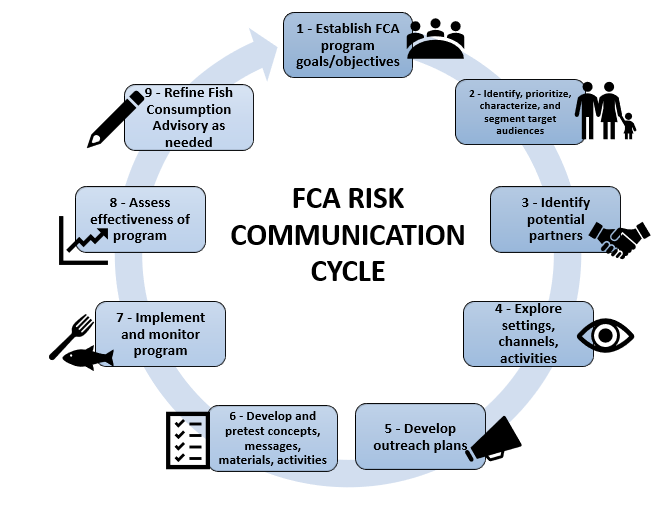1 - Establish Program Goals and Communication Objectives
The first step for developing and implementing a risk communication program for fish and shellfish consumption advisories is to establish appropriate goals and objectives that convey risks to public health. Establishing Fish Consumption Advisory (FCA) goals and objectives is an iterative, not necessarily a linear, process. Some of the planning activities could, and likely will, happen simultaneously. Planning is important, because it helps to:
- Identify the approaches necessary to bring about or support the desired change
- Establish a logical program development process
- Create a FCA program that supports clearly defined objectives
- Set priorities, assign responsibilities
- Assess progress
- Save time over the long run
Getting Started
FCAs can be used to change fish consumption behavior among target audiences. That is, FCAs can help people make informed choices about which waters to fish in, which species to eat, and how often to eat them. Get started by:
- Developing risk communication materials after obtaining the technical information, e.g., information on the contaminants and their health impacts, contaminant levels in specific fish species, and types of fish impacted
- Checking existing information, including existing FCAs, regarding the incidence or prevalence of the exposure to the contaminated fish, i.e. which human populations, if any, are currently being over-exposed
- Identifying existing activities and gaps – find out what other agencies are doing to address the same type of contaminants in the same type of fish, e.g., talk to other states, territories, or tribes to find out what they have done and what they have learned
Develop a timeline for help with planning. Produce a time schedule for development, implementation and evaluation. The timeline is a flexible management tool as it can be reviewed, updated and used to manage and track progress. Ensure that the timeline addresses all the important parts of the FCA communications, including, at least:
- Securing necessary resources, hiring staff, recruiting volunteers, training, pretesting, implementation, monitoring, etc.
- Estimated start and completion dates for each activity, including long-term and repeated activities
- Major deadlines, including due dates for deliverables, accomplishments, reports, etc.
- Specific personnel or organization(s) responsible for each task or activity
Identify FCA Program Goal
The FCA Program Goal is the overall health improvement that an organization strives to create, e.g., switching from eating more to less contaminated fish for women of child-bearing age. A FCA program should be designed to support and contribute to achieving the FCA Program Goal.
Define Communication Objectives
Communication Objectives are the specific communication outcomes to be produced in support of the overall FCA Program goal (e.g., by a specified date, 90% of women of child-bearing age will consume fish that are within the limits of safe exposure to mercury). Communication Objectives should be attainable, measurable, and time-bound. These Communication Objectives should be evaluated to determine how well a FCA is working toward meeting the FCA Program Goal.
Defining Communication Objectives will help priority setting among possible communication activities, e.g., activities undertaken to communicate the FCA and help determine the message and content for each. Once Communication Objectives are defined, they serve to provide an understanding about the purpose of the communication, and they establish what outcomes can be measured. Without objectives, it can be challenging to evaluate whether the program is making progress or has achieved its goals. Objectives should be supportive of the FCA’s goals.
Communication Objectives should be SMART (Specific, Measurable, Achievable, Realistic, Time-bound):
- Specific to the change desired, the target population(s) to be affected, and the time period during which change should take place
- Measurable, to allow progress to be tracked and know when the goal has been achieved
- Achievable. Consider:
- Whether or not the objectives can be achieved given available and future resources
- Staff and other human resources, including people from other programs and partners
- Overhead resources, e.g., computer time, mailing costs, and printing
- Services or expertise from other organizations, including partners
- Existing barriers, e.g., sensitivity to modifying fish consumption on the part of members of target audiences
- Realistic
- Raising awareness or increasing knowledge among target audiences is feasible; however, it does not necessarily mean that behavior will change in all members of the target population
- Ability and willingness of target audience(s) to make certain changes affect the reasonableness of Communication Objectives
- Time-bound, identify the time period during which change should take place
Plan a Budget
When planning the FCA’s budget take evaluation costs into account so that the FCA can be adequately evaluated to determine how well the program is working and adjustments can be made if necessary. The general recommendation is to use 10% of program funding for evaluation. The budget can be flexible and should be reviewed periodically and adjusted if needed. As with any budget, it is important to document spending, keep track of expenses, and track and take inventory of program supplies. It may be helpful to designate someone to keep track of spending and funds.
Use the template to help plan the budget and keep track of spending.
| Item | Jan/Year | Feb/Year | March/Year | April/Year | May/Year, etc. |
|---|---|---|---|---|---|
| Evaluation Staff | |||||
| Consultants/Partners | |||||
| Travel | |||||
| Communication | |||||
| Printing Materials | |||||
| Supplies and Equipment | |||||
| Incentives | |||||
| Other/Miscellaneous | |||||
| TOTAL |
-
EPA Guidance
-
Fish Consumption Survey Tool (FCST) (zip)(1 pg, 3 MB)

